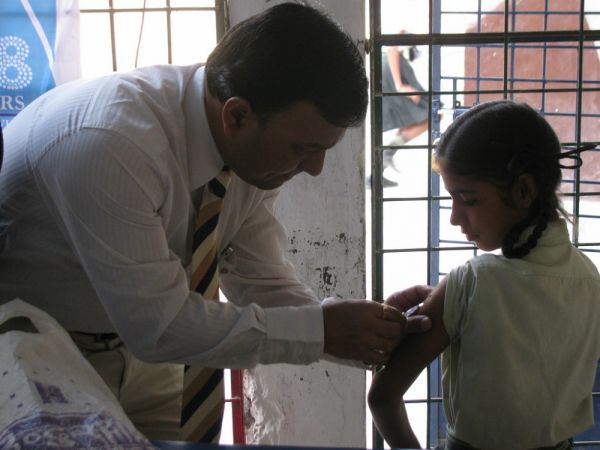As Urbanization Changes the Way We Get Sick, Health Care Adapts

A pilot program aimed at addressing the needs of chronic disease sufferers in poor urban communities is showing promising results. Photo credit: Rotary Club of Nagpur
The transformations wrought by global urbanization are many. Poverty is falling. Pollution is rising. The developing world is flexing its muscles, empowered by its ballooning cities.
But one of the biggest changes caused by the great migration to urban areas is one you rarely think about: The dramatic shift in how we get sick. For nearly all of human history, infectious diseases – malaria, tuberculosis, hepatitis – have been the biggest threats to human health. Now, chronic diseases have become the larger hazard. These are long-term, non-communicable illnesses like cancer and diabetes that are caused by sedentary lifestyles, processed food and, to some degree, the very fact that we’re living longer. Over the next decade, chronic diseases are projected to increase by 15 percent. Already, in all but the poorest countries, these illnesses now cause more disability and death than infectious ones.
Urbanization explains much of this shift, so it’s not surprising that a recent pilot project on how health-care systems should respond was conducted by the New Cities Foundation. The foundation’s “Task Force on E-Health” set out to test a replicable, cost-effective health-care model that leverages technology to provide improved access to primary health care in urban communities. For their case study they chose a clinic in Santa Marta, a neighborhood of Rio de Janeiro, equipping the staff with the tools to collect data and create comprehensive diagnoses for 100 patients suffering from chronic diseases.
Rio is a perfect microcosm for what’s happening in cities the world over. Obesity among the poor is rising, and informal settlements, where primary health care is scarce, are growing rapidly. Santa Marta is one of these settlements. Perched on a very steep hillside, its location makes getting around difficult for the neighborhood’s chronic disease sufferers, of which there are many. The Task Force outfitted the staff at Santa Marta’s clinic with backpacks containing “e-health kits” – portable medical tools used to detect and monitor things like blood pressure and glucose levels. The backpacks made it easy for staff to make home visits to patients and “detect an average of 20 different diseases such a hypertension and diabetes within minutes.”
The pilot project in Santa Marta ran from August 2012 to March 2013, and the results are promising. “Improved patient monitoring and timely disease diagnosis and treatment contributed to the reduction or avoidance of chronic disease conditions requiring expensive treatment or hospitalization, delivering major cost savings to the public health-care system,” an analysis of the experiment concludes.
How much savings? For kidney dysfunction: $200,541 per 100 patients per year. For strokes: $32,521. For heart failures: $4,002. “Given the high cost of these treatments, the e-health pilot demonstrates the opportunity for significant cost savings in Brazil: Over $200,000 USD per 100 patients per year,” says the report.
In many ways, such a system seems custom-made for poorer, informal communities – it better addresses their changing medical needs, and enhances their bare-bones clinics with high-tech medicine. But cost is a factor: At $42,000 USD per kit, the backpacks aren’t cheap. And while the long-term savings they generate might surpass any initial cost, getting politicians to see it that way could take time, especially since the people who stand to benefit most are the urban poor and informal settlers.
But if the health-care woes of countries like the U.S. have taught us anything, it’s that leaving a large portion of the population underserved can drag the whole system to its knees. “The key lesson that the Task Force has learned… is that high-tech solutions can – and should – be used where there is great need,” the report concludes. “Rather than wait for innovation and progress to trickle down to underserved communities, city leaders should begin looking where it is needed most, and deploy the best technology available.”









